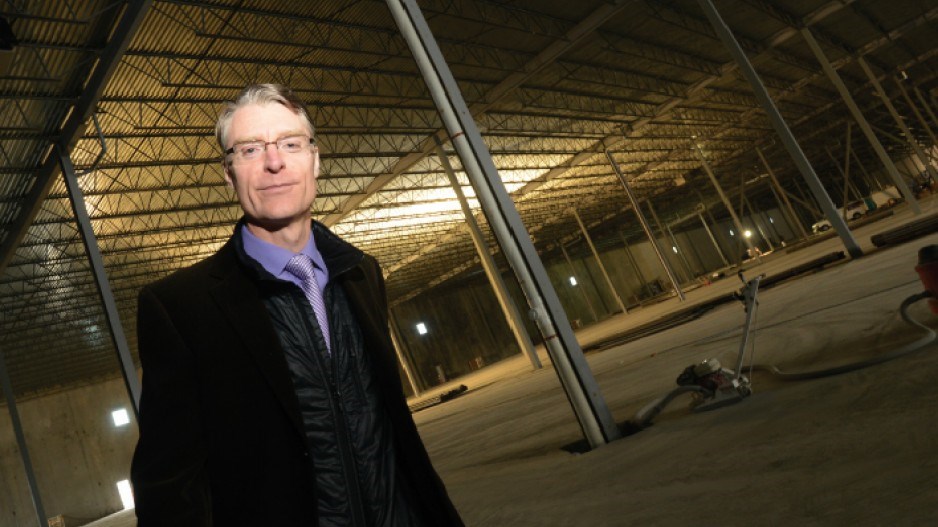Metro Vancouver’s limited industrial land supply could be a little less dire as existing properties host more intensive forms of development, says one broker.
Pointing to the raft of large-format, high-ceiling warehouses under construction around the Lower Mainland, often on older, low-density industrial sites, CBRE Ltd. senior vice-president Gurch Ollek said he believes the market will respond to the demand for new development opportunities.
“I’m not a believer in an industrial land shortage,” Ollek said. “My view is that we’re going to have opportunities come up like Interfor [in New Westminster] – that was a sawmill, already an industrial use, frees up 50 more acres for industrial use.”
The Beedie Group recently signed an agreement to develop 35 acres of the Interfor site, owned by Port Metro Vancouver, with logistics space. The first building, a 45,000-square-foot cross-dock facility for Damco, is set to complete this summer.
Ollek said several older buildings in Burnaby’s Lake City area are poised for transformation into high-bay, high-performance industrial buildings, and with calls for the replacement of the Patullo Bridge gathering momentum, new opportunities in New Westminster and Surrey are bound to emerge at either end of that crossing.
“[There are] acres and acres of underutilized industrial land,” Ollek said. “Once the transportation system gets put through there and access improves, I believe a lot of those areas will go to a higher and better industrial use.”
Recent development on port property in Richmond points the way forward.
Building on a 40-year vision, the port has worked with developers such John Robertshaw of Brunswick Property Holdings Ltd. to develop a 700-acre parcel in East Richmond for a nexus of importers and exporters including Euro Asia Transload Terminals Inc. and Coast 2000 that reduces container movement between sites and storage requirements.
Those same logistics and distribution companies have also pioneered the large-format warehouses that define new-generation industrial space in the Lower Mainland.
Beginning with a 486,000- square-foot facility Hopewell Development Corp. developed for importer Containerworld Forwarding Services Inc. in 2008, warehouses in the region now routinely run between 400,000 and 600,000 square feet – at least three times what a major developed warehouse was 10 years ago.
Deals are larger because container traffic through Vancouver is up.
The port handled 2.7 million TEUs (20-foot equivalent units, the industry standard for measuring container traffic) in 2012, and Tom Corsie, vice-president, real estate for the port, expects the volume to hit 7.5 million TEUs by 2030. The port’s current capacity is 3.7 million TEUs.
Deltaport’s expansion will handle the incoming containers, but space is also needed once cargo is off the boat – by the port’s estimate, about 2,300 acres. A fraction of that is available for development today.
While the port has stepped up the acquisition of strategic properties in recent years, from old mill properties to riverfront farms, making better use of its available land is integral to growth.
The large-scale distribution facilities in Richmond show how that might happen.
“From the port’s point of view, this is an excellent use of property,” Corsie said.
But there’s a catch.
Sites need to be central to the region’s container terminals, and many of the best sites are trading at values in the range of $1.5 million an acre. This makes older warehouse properties on Annacis Island and in Burnaby’s Lake City area too expensive to redevelop, unlike former mill sites or the 300 acres of greenfield property held by Tsawwassen First Nation.
“It would make good planning sense,” Corsie said of redevelopment. “Does it make any financial sense? I’m not really sure it does.”
Richard Wozny, principal of real estate consulting firm Site Economics Ltd., which has analyzed many of the region’s major industrial projects, agrees.
He can’t think of a single example where this has happened, although Triovest Realty Advisors Inc. plans to reconfigure two former manufacturing facilities totalling 280,000 square feet as South Fraser Industrial Centre for logistics users. It’s not a full-on redevelopment, however.
Wozny said it will take an acute shortage of land before owners consider the large-scale redevelopment of existing sites.
“Theoretically, you could take an old dilapidated warehouse, knock it down and put in high-value, high-quality flex space,” he said. “While it’s not common yet, it is expected with time – in 10 to 20 years – that industrial areas will age to the point where the high land value and low rent from some large old building will not be sufficient, and the owners will come in [and] remove the building.” •




